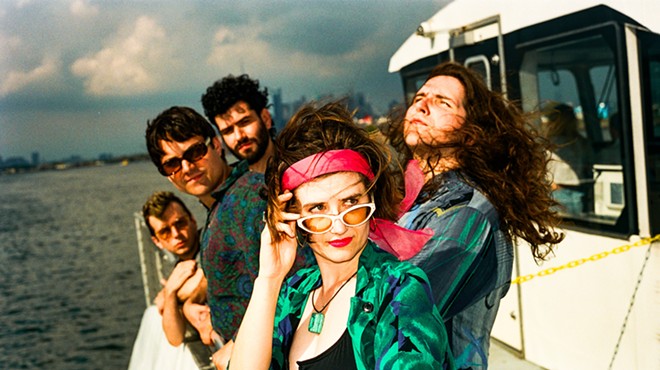In the Pittsburgh Center for the Arts' tersely named exhibition Cluster, more than 20 local artists of diverse ages, backgrounds and media fill the entirety of the building's galleries with recent work. It's an impressive spread, with modestly sized paintings asserting themselves as well as wall-length projections.
Jacob Ciocci's "Trapped and Frozen Forever" is the most starkly laid out, and the most penetrating, that I've seen his work. On the gallery's far wall is projected a sort of moving collage. Its content is an unruly congregation of "gif" files and YouTube fodder, with seemingly no relevant links between them. Characteristic Ciocci motifs -- emoticons, painstakingly cut-and-pasted film clips, and neon bolts and bursts -- subsume the eye in calamitous over-saturation. The twitching canvas is intermittently obliterated by a grasping green hand that serves as both enforcer of order and demon-guide to the flummoxed viewer (and that sometimes shares the stage with Carol Anne from the movie Poltergeist).
Not surprisingly, Ciocci professes his work to be Internet-related, and it's that endless landscape of nonlinear information-retrieval that this piece represents. Exaggerating and vilifying the trauma of the unrestricted flow of megabytes, "Trapped" is intentionally overwhelming. The viewer is challenged to navigate the pandemonium, and thereby prevail. It's the re-emergence of his own consciousness that brings him out safely on the other side of a Day-Glo underworld.
I didn't think there was much more to say about the dubious satisfactions of suburbia and pre-packaged housing plans, but Jason Lee's "Euthenic Set: Suburban Landscape" manages a playfully tangible new illustration of this old critique. The installation revels in its sterile plasticity, with factory-perfect miniature white-picket fences bounding playground-orange pedestals, each providing the back-light for an inkjet transparency of improbably green grass or rippling water. Mounted on the walls are matching light-boxes supplying the wispy nimbus clouds of a temperate June morning. Lee upholds the facade even in the piece's text, huckstering, "Why have the real thing when the allergy-free facsimile is readily available and easily configurable to fit any interior space?"
A few more humbly scaled works caught my attention, among them David Montano's dime-novel-sized collages "For Privacy" and "Armchair Detective." Both incorporate rectangular fragments of book and ledger pages, fabric and playing cards, among other things, assembled in precise, quiet compositions. Likewise, Kyle Houser's "Poppy Field" marries expressive entropy with plodding craftsmanship, posing lumpy stoneware as fine china decked out in ornate flower motifs.
In the second floor's rear-most gallery, Michael Scherwin's "True North," a succession of 10 wall-mounted photo prints, finds an atmospheric beauty in the refraction, condensation and cohesion of water droplets accumulating on the North Pole Webcam. The surprising reds and oranges in a powder-blue ground remind the viewer of daylight's gorgeous little tricks. Nearby, Dee Briggs' hanging sculpture "3 Steel Rings" seems skeletal and spare, but a brief look reveals it to be robust and dynamic, undulating as the viewer circles it.
In titling his show Cluster, Center for the Arts curator Adam Welch attempts to assign a theme to themelessness. That's not really a criticism; sometimes imposing an over-arching idea can establish relationships between apparently disparate works and artists.
In his curatorial statement, Welch says he gleaned the term from the world of scientific research. A "cluster" offers a researcher "a digestible amount of data" for assessing "characteristics, values and traits." This, Welch writes, prevents one's getting "lost in a model derived from an overwhelming collection of details."
But ironically, it's largely an avoidance of common "characteristics, values and traits" that makes Cluster what it is. While I found the show's pursuit of plurality at times disorienting, it's ultimately successful as an energetic, untethered survey of work going on in Pittsburgh studios. Each piece or body of work necessitates its own mode of viewing, but most of it is well worth the effort.
Cluster continues through March 28. Pittsburgh Center for the Arts, 6300 Fifth Ave., Shadyside. 412-361-0873 or www.pittsburgharts.org















